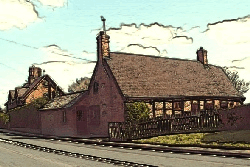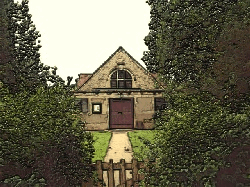|
.
There's the modern village of Highnam, an example of 20th century speculative development. It was born out of an idea for a garden village which was to have lots of
green space and the local facilities to cement the community together.
A short walk away is the small, relatively compact, hamlet of Lassington. It was an
ancient manor, though never a grand one. From Highnam village, you can look down towards Lassington and see fields where people have toiled for well over a thousand years.

The district of Highnam is different again. It too has been farmed for many centuries, but it also has its
grand house - Highnam Court, once the country seat of some of the county's wealthiest families. Here, there have been farmers and farm labourers and their
families, but there have also been maids, and footmen, grooms and butlers, and gardeners and masons and gamekeepers, all working on the estate to serve the lord of the manor and his family. Here
too, is Highnam church, an architectural gem today, but an edifice which must have amazed the local people when it was built in 1851.
Nearby Linton seems to be something of an enigma.
It's flat and almost featureless and seems to contain little of any real interest. It has its single farm, with acres of obviously rich
agricultural land, lying as it does on the flood plain of the river Severn. But it has obviously been more in the past. A whole hamlet of small farms and cottages has
disappeared. Its meadow land - Mickle Mead, was once crucial for the sustenance of the whole community. Kings and Queens have passed this way, as well as the
New Model Army, who helped get rid of one of their number. You can also add the Romans, their Silurian enemies, and countless other travellers. Linton also has its
railway line. Taken for granted today, it is still something of a mini wonder of the world, certainly an amazing engineering achievement, built as it was with the
sweat and toil of literally thousands of navvies.

To the modern day traveller through Over,
the place might appear to be just a large ribbon of cement, with a pub/restaurant, a shop and a few houses. Even the bridges, which have given Over its importance since
Roman times, may be ignored as you drive by. But in the mid nineteenth century, Over was described as a perfect English village. Then it had its elegant new road bridge, the
main gateway between Wales and England, and it was a thriving community.
The development of the railway to Wales, started a rot, which was finished by the development of the 'speculative' railway to Ledbury and Newent. The village
was cut into small pieces, and all but destroyed by that. Only now with the recent housing development and the redevelopment of the Canal Basin may we
see the beginnings of the restoration of some of its original character.
|